Abstract
The value of exercise testing in detecting myocardial ischaemia resulting from coronary atheroma remains controversial. In order to increase the reliability of exercise testing, all its components (asymptomatic, haemodynamic, and electrocardiographic) have been scrutinised. In this study, concerned only with the electrocardiographic response to exercise, the incorporation of beta-blockade into the standard exercise procedure has improved specificity and predictive value without affecting sensitivity. Fifty patients with anginal pain and 50 asymptomatic subjects with an abnormal electrocardiogram were investigated by exercise testing before and after beta-blockade (oxprenolol). All subjects had coronary arteriograms and left ventriculograms, and the results of exercise testing were related to the presence or absence of obstructive coronary artery disease. Possible causes of false positive exercise tests were eliminated by echocardiography. Though beta-blockade was unreliable in distinguishing ischaemic from non-ischaemic resting electrocardiograms, it eliminated all the false positive electrocardiographic responses to exercise in both groups and did not abolish any of the true positive electrocardiographic responses. Thus, specificity and predictive value were improved without reduction in sensitivity. This technique may not necessarily be applicable to other groups of patients or to a random population, but the results of this study suggest it will be a useful additional routine procedure in the investigation of coronary heart disease.
Full text
PDF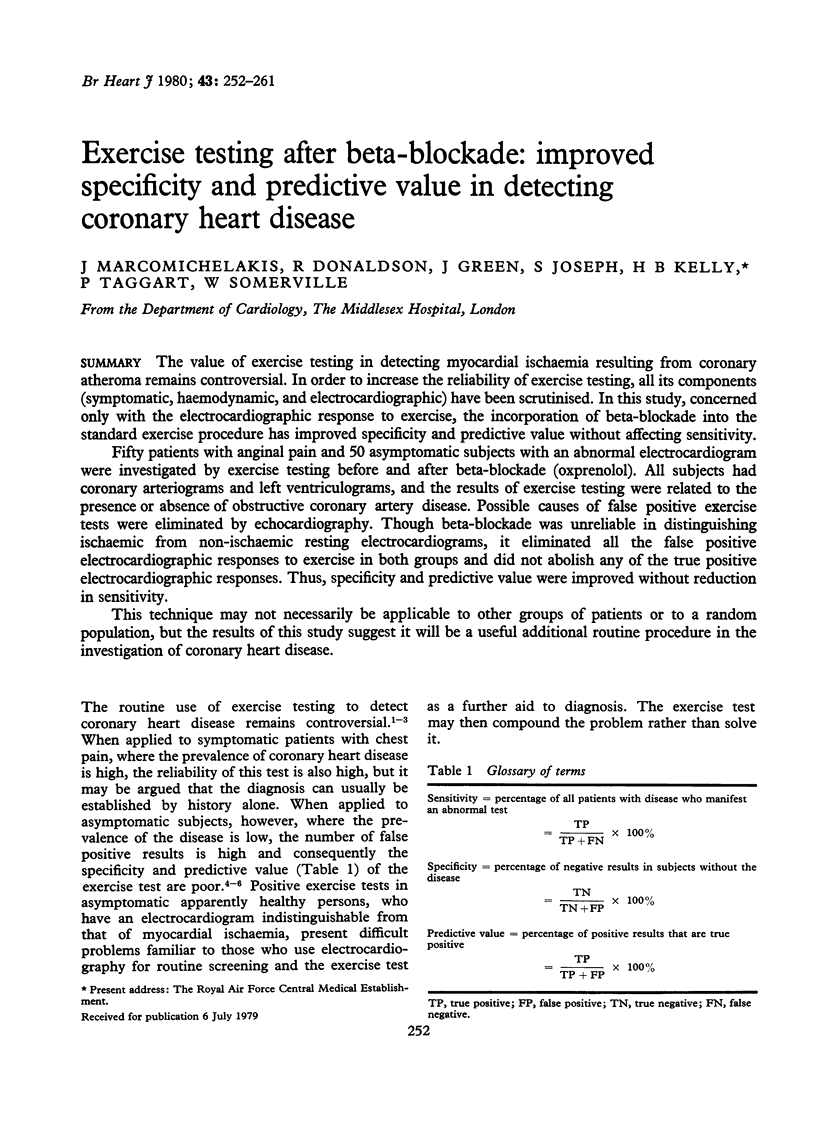
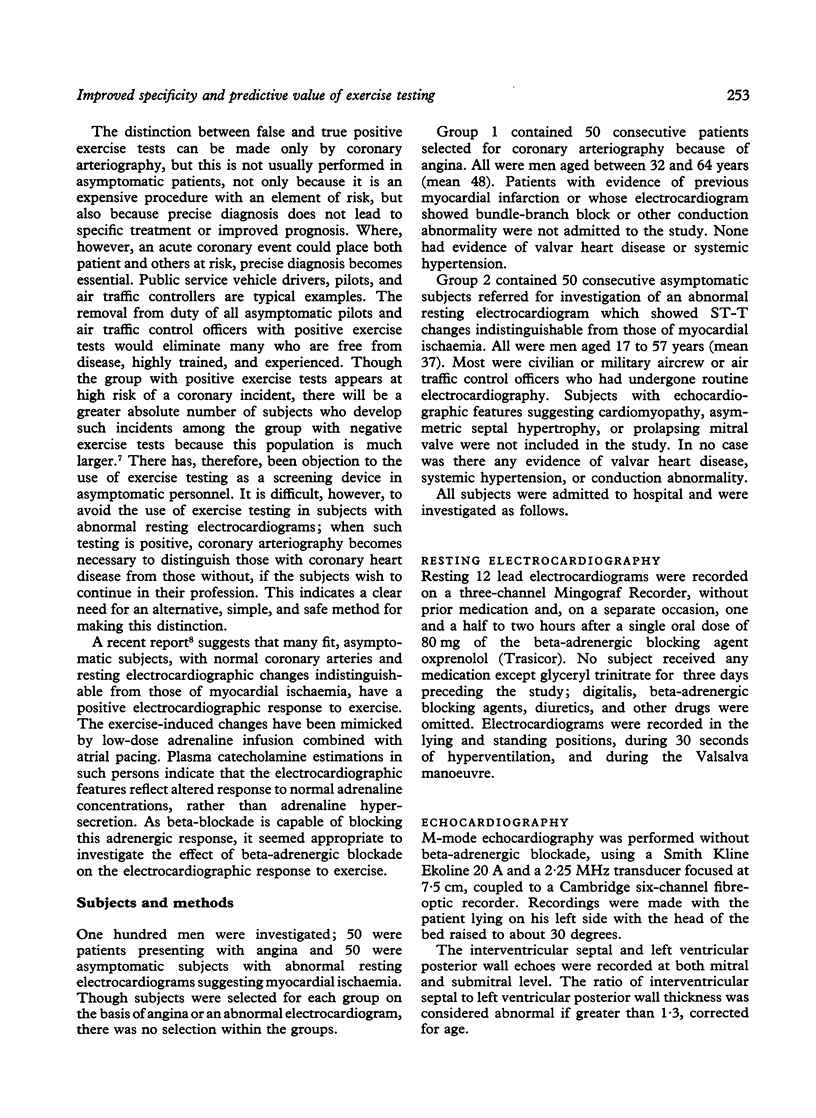
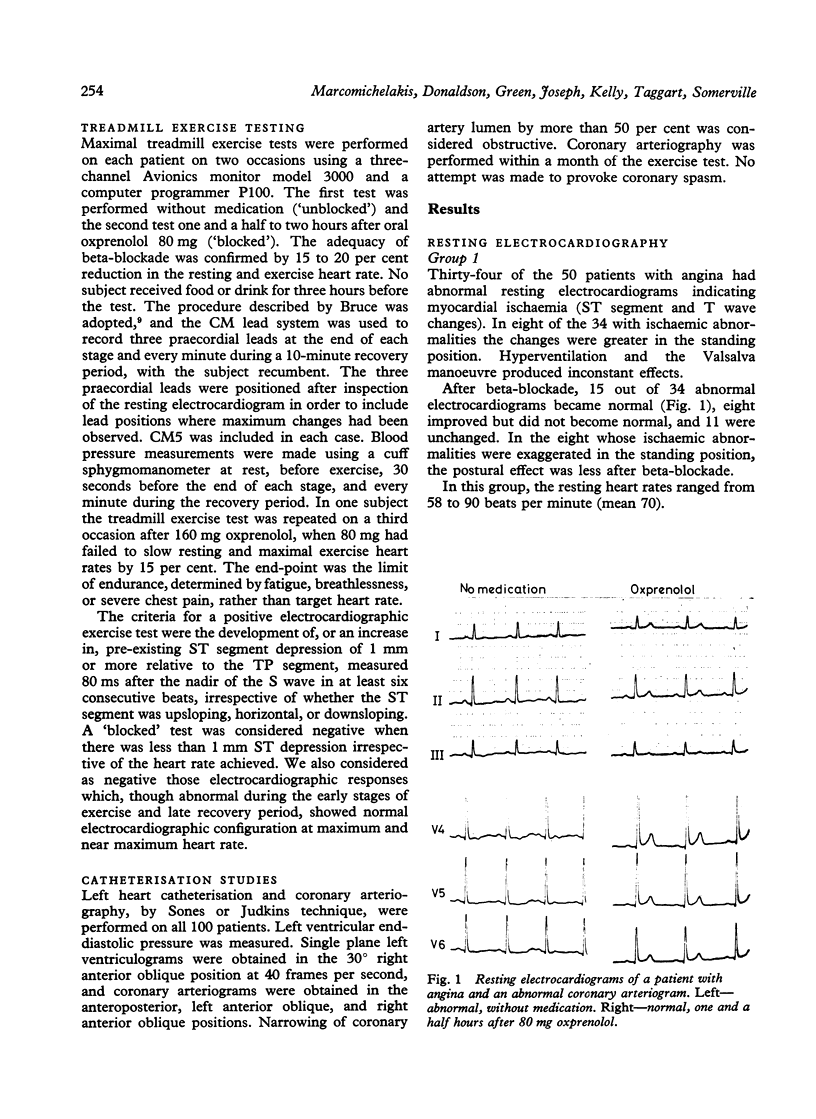
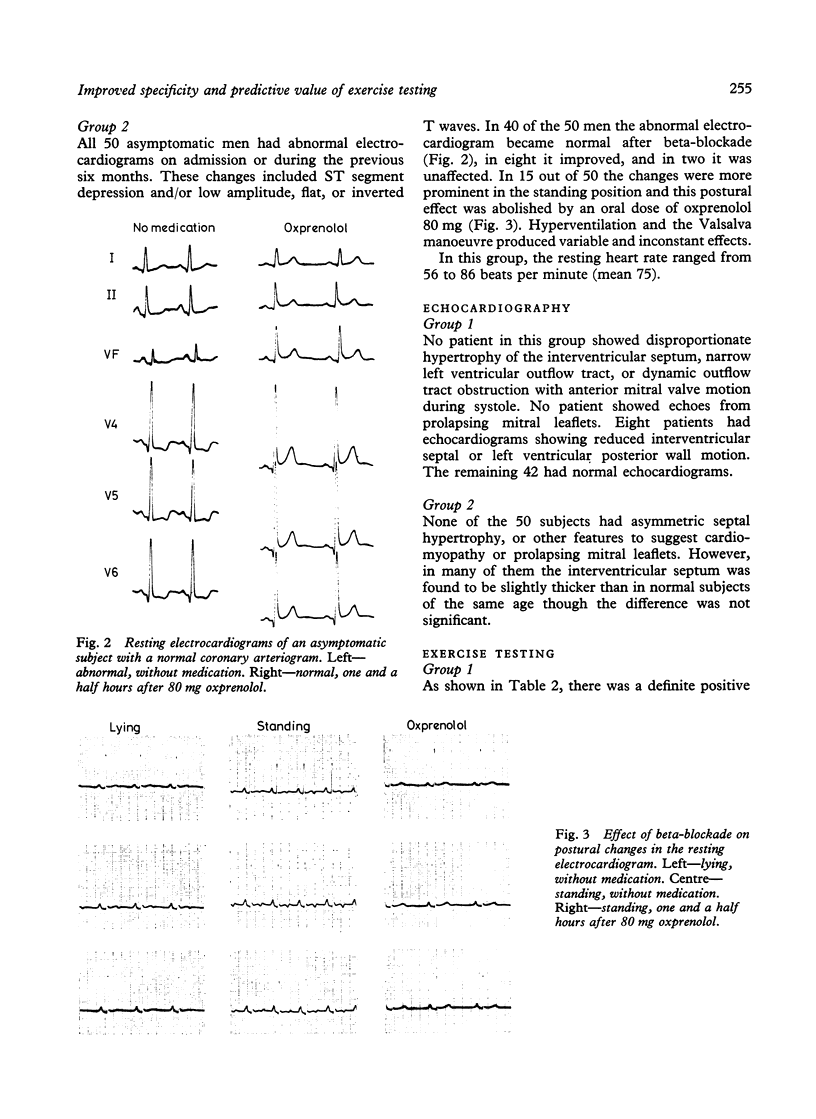
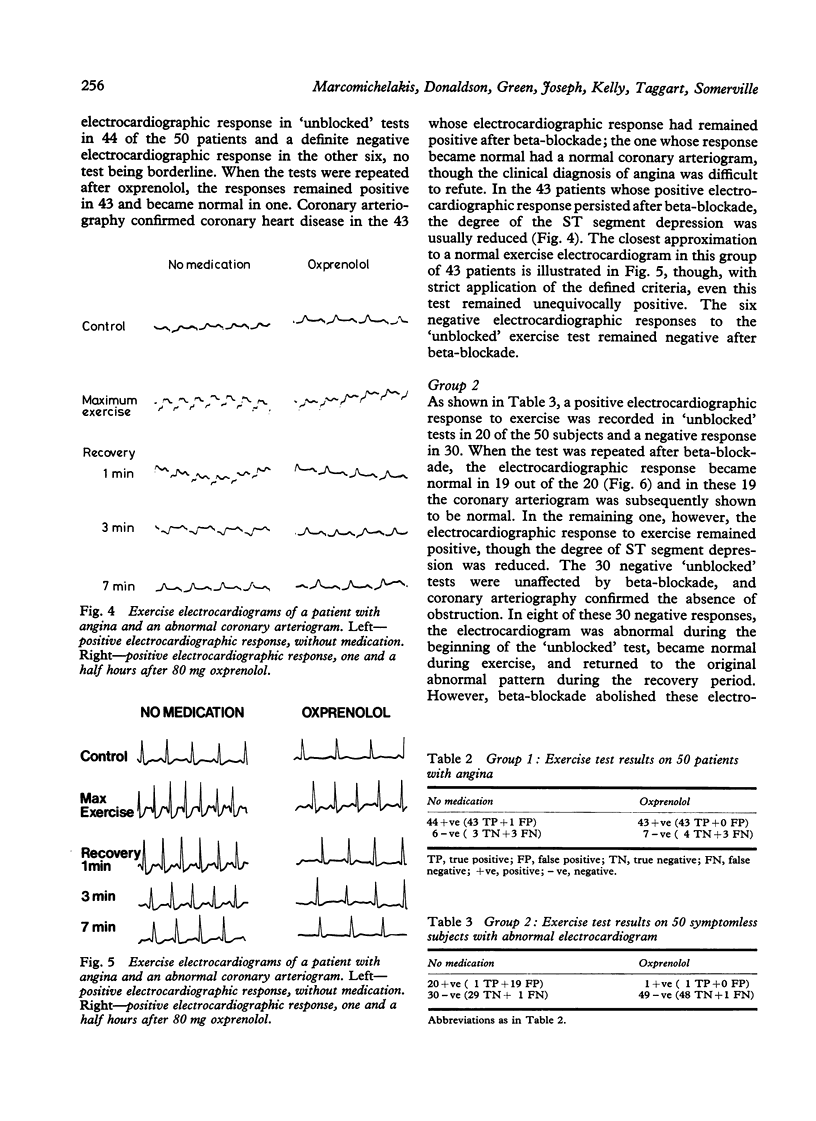
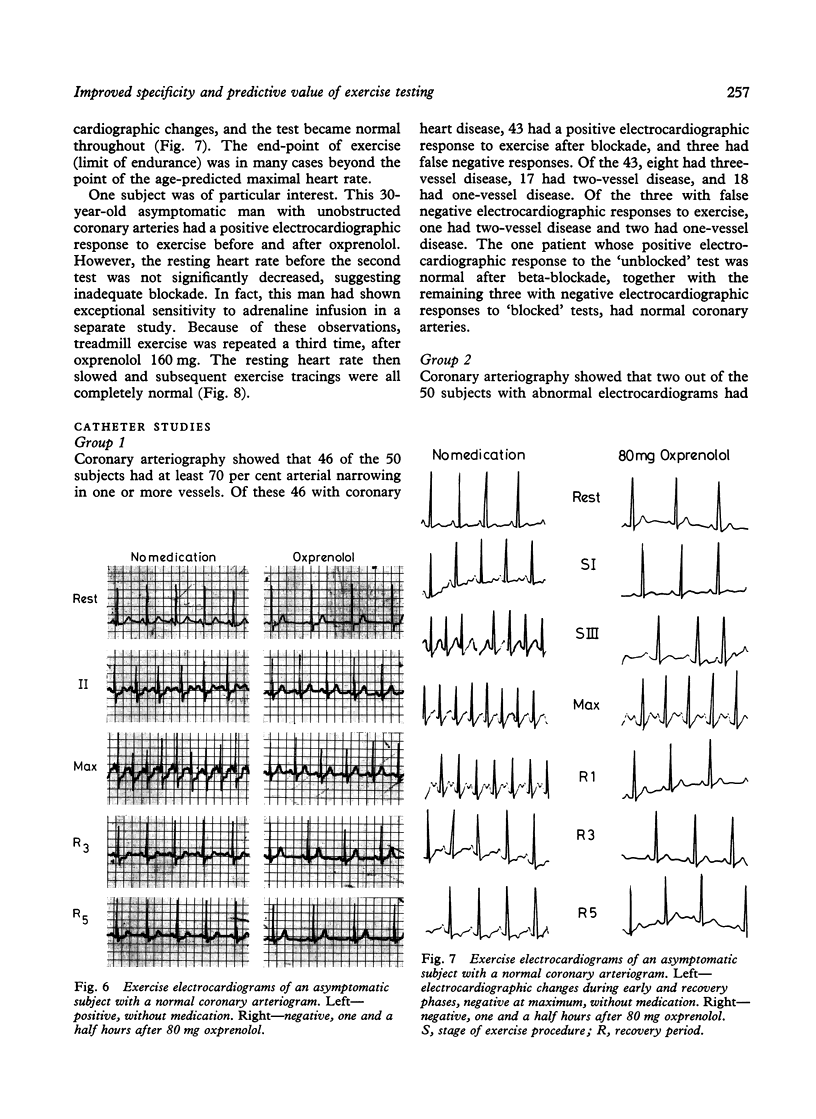
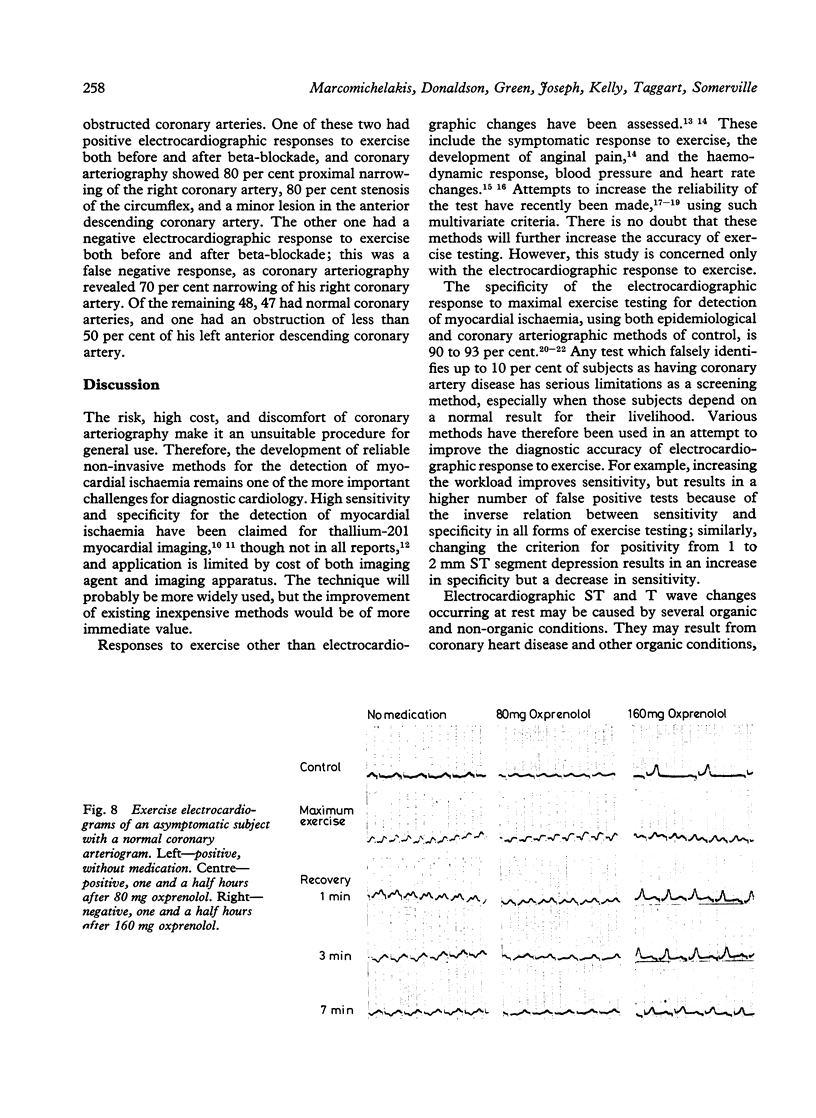

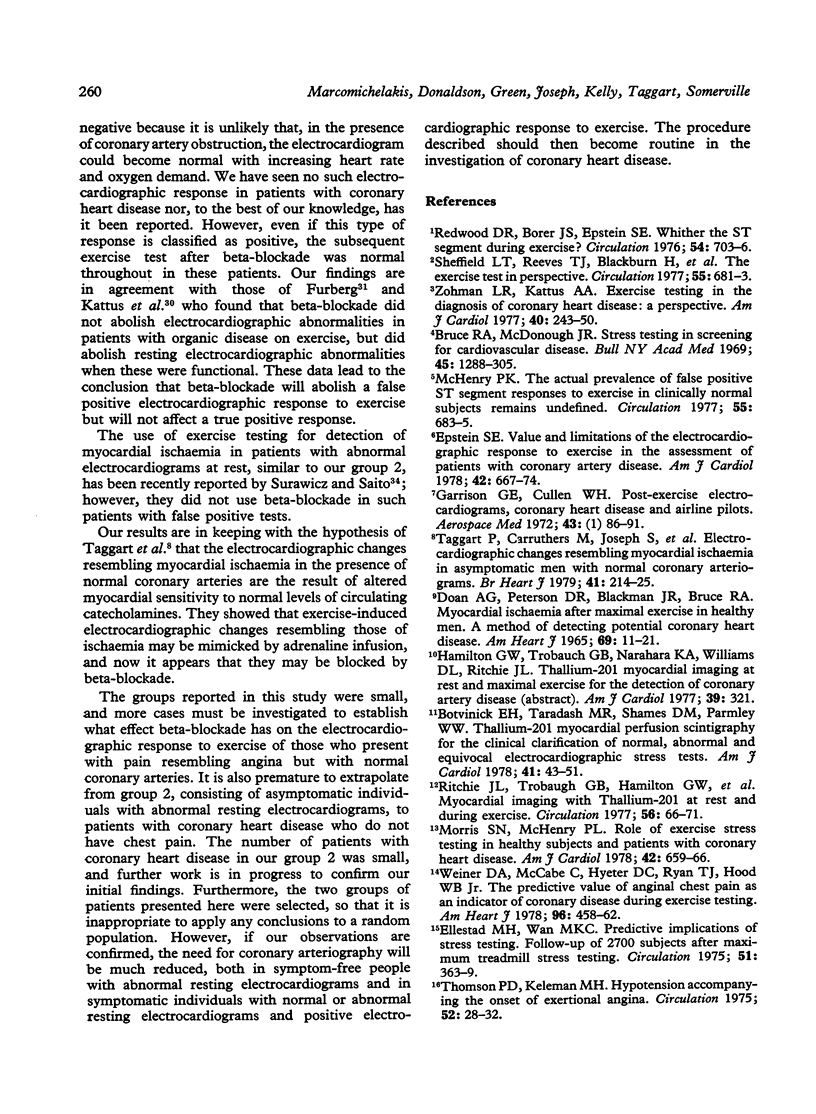
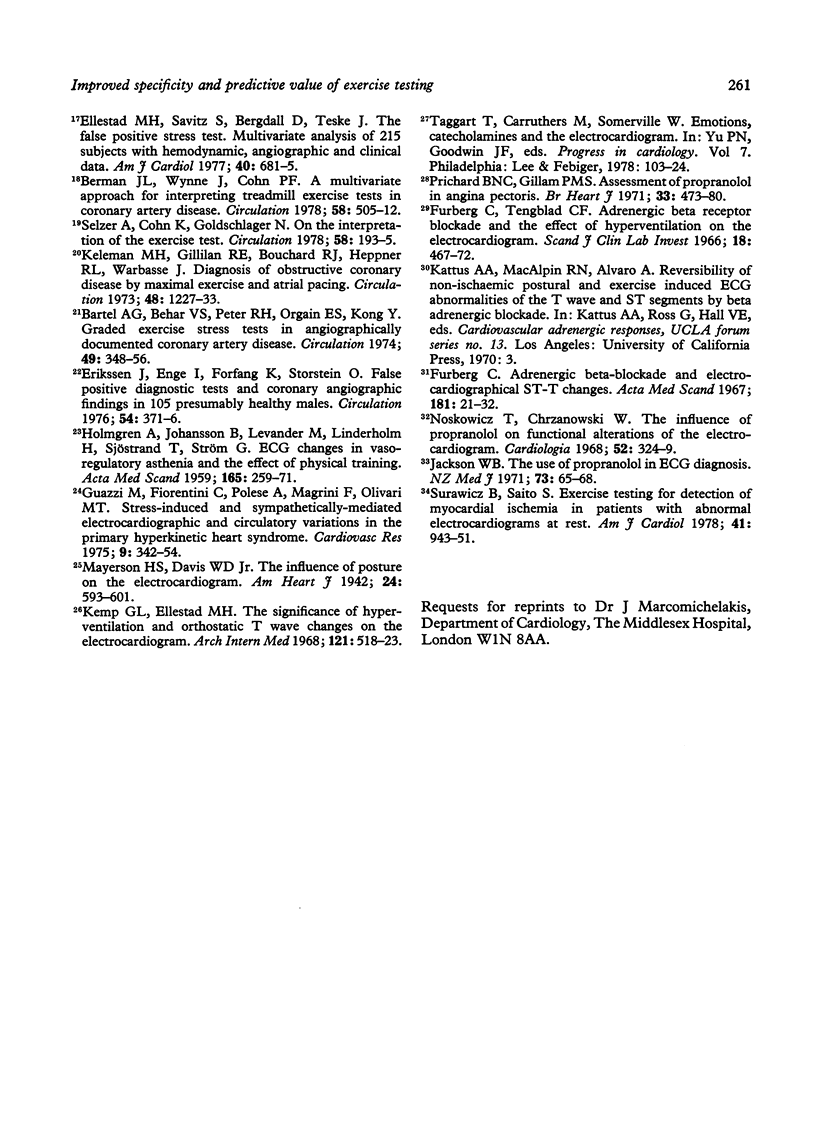
Selected References
These references are in PubMed. This may not be the complete list of references from this article.
- Bartel A. G., Behar V. S., Peter R. H., Orgain E. S., Kong Y. Graded exercise stress tests in angiographically documented coronary artery disease. Circulation. 1974 Feb;49(2):348–356. doi: 10.1161/01.cir.49.2.348. [DOI] [PubMed] [Google Scholar]
- Berman J. L., Wynne J., Cohn P. F. A multivariate approach for interpreting treadmill exercise tests in coronary artery disease. Circulation. 1978 Sep;58(3 Pt 1):505–512. doi: 10.1161/01.cir.58.3.505. [DOI] [PubMed] [Google Scholar]
- Botvinick E. H., Taradash M. R., Shames D. M., Parmley W. W. Thallium-20 1 myocardial perfusion scintigraphy for the clinical clarification of normal, abnormal and equivocal electrocardiographic stress tests. Am J Cardiol. 1978 Jan;41(1):43–51. doi: 10.1016/0002-9149(78)90130-3. [DOI] [PubMed] [Google Scholar]
- Bruce R. A., McDonough J. R. Stress testing in screening for cardiovascular disease. Bull N Y Acad Med. 1969 Dec;45(12):1288–1305. [PMC free article] [PubMed] [Google Scholar]
- DOAN A. E., PETERSON D. R., BLACKMON J. R., BRUCE R. A. MYOCARDIAL ISCHEMIA AFTER MAXIMAL EXERCISE IN HEALTHY MEN. A METHOD FOR DETECTING POTENTIAL CORONARY HEART DISEASE? Am Heart J. 1965 Jan;69:11–21. doi: 10.1016/0002-8703(65)90211-5. [DOI] [PubMed] [Google Scholar]
- Ellestad M. H., Savitz S., Bergdall D., Teske J. The false positive stress test. Multivariate analysis of 215 subjects with hemodynamic, angiographic and clinical data. Am J Cardiol. 1977 Nov;40(5):681–685. doi: 10.1016/0002-9149(77)90182-5. [DOI] [PubMed] [Google Scholar]
- Ellestad M. H., Wan M. K. Predictive implications of stress testing. Follow-up of 2700 subjects after maximum treadmill stress testing. Circulation. 1975 Feb;51(2):363–369. doi: 10.1161/01.cir.51.2.363. [DOI] [PubMed] [Google Scholar]
- Epstein S. E. Value and limitations of the electrocardiographic response to exercise in the assessment of patients with coronary artery disease. Controversies in cardiology--II. Am J Cardiol. 1978 Oct;42(4):667–674. doi: 10.1016/0002-9149(78)90639-2. [DOI] [PubMed] [Google Scholar]
- Erikssen J., Enge I., Forfang K., Storstein O. False positive diagnostic tests and coronary angiographic findings in 105 presumably healthy males. Circulation. 1976 Sep;54(3):371–376. doi: 10.1161/01.cir.54.3.371. [DOI] [PubMed] [Google Scholar]
- Furberg C., Tengblad C. F. Adrenergic beta-receptor blockade and the effect of hyperventilation on the electrocardiogram. Scand J Clin Lab Invest. 1966;18(5):467–472. doi: 10.3109/00365516609103907. [DOI] [PubMed] [Google Scholar]
- Garrison G. E., Gullen W. H. Postexercise electrocardiograms, coronary heart disease, and airline pilots. Aerosp Med. 1972 Jan;43(1):86–91. [PubMed] [Google Scholar]
- Guazzi M., Fiorentini C., Polese A., Magrini F., Olivari M. T. Stress-induced and sympathetically-mediated electrocardiographic and circulatory variations in the primary hyperkinetic heart syndrome. Cardiovasc Res. 1975 May;9(3):342–354. doi: 10.1093/cvr/9.3.342. [DOI] [PubMed] [Google Scholar]
- HOLMGREN A., JONSSON B., LEVANDER M., LINDERHOLM H., SJOSTRAND T., STROM G. ECG changes in vasoregulatory asthenia and the effect of physical training. Acta Med Scand. 1959 Nov 18;165:259–271. doi: 10.1111/j.0954-6820.1959.tb14499.x. [DOI] [PubMed] [Google Scholar]
- Jackson W. B. The use of propranalol in ECG diagnosis. N Z Med J. 1971 Feb;73(465):65–68. [PubMed] [Google Scholar]
- Kemp G. L., Ellestad M. H. The significance of hyperventilative and orthostatic T-wave changes on the electrocardiogram. Arch Intern Med. 1968 Jun;121(6):518–523. [PubMed] [Google Scholar]
- McHenry P. L. The actual prevalence of false positive ST-segment responses to exercise in clinically normal subjects remains undefined. Circulation. 1977 May;55(5):683–685. doi: 10.1161/01.cir.55.5.683. [DOI] [PubMed] [Google Scholar]
- Morris S. N., McHenry P. L. Role of exercise stress testing in healthy subjects and patients with coronary heart disease. Controversies in cardiology--I. Am J Cardiol. 1978 Oct;42(4):659–666. doi: 10.1016/0002-9149(78)90638-0. [DOI] [PubMed] [Google Scholar]
- Noskowicz T., Chrzanowski W. The influence of propranolol on functional alterations of the electrocardiogram. Cardiologia. 1968;52(6):324–329. doi: 10.1159/000166134. [DOI] [PubMed] [Google Scholar]
- Prichard B. N., Gillam P. M. Assessment of propranolol in angina pectoris. Clinical dose response curve and effect on electrocardiogram at rest and on exercise. Br Heart J. 1971 Jul;33(4):473–480. doi: 10.1136/hrt.33.4.473. [DOI] [PMC free article] [PubMed] [Google Scholar]
- Redwood D. R., Borer J. S., Epstein S. E. Whither the ST segment during exercise. Circulation. 1976 Nov;54(5):703–706. doi: 10.1161/01.cir.54.5.703. [DOI] [PubMed] [Google Scholar]
- Ritchie J. L., Trobaugh G. B., Hamilton G. W., Gould K. L., Narahara K. A., Murray J. A., Williams D. L. Myocardial imaging with thallium-201 at rest and during exercise. Comparison with coronary arteriography and resting and stress electrocardiography. Circulation. 1977 Jul;56(1):66–71. doi: 10.1161/01.cir.56.1.66. [DOI] [PubMed] [Google Scholar]
- Selzer A., Cohn K. On the interpretation of the exercise test. Circulation. 1978 Aug;58(2):193–195. doi: 10.1161/01.cir.58.2.193. [DOI] [PubMed] [Google Scholar]
- Sheffield L. T., Reeves T. J., Blackburn H., Ellestad M. H., Froelicher V. F., Roitman D., Kansal S. The exercise test in perspective. Circulation. 1977 May;55(5):681–682. doi: 10.1161/01.cir.55.5.681. [DOI] [PubMed] [Google Scholar]
- Surawicz B., Saito S. Exercise testing for detection of myocardial ischemia in patients with abnormal electrocardiograms at rest. Am J Cardiol. 1978 May 1;41(5):943–951. doi: 10.1016/0002-9149(78)90738-5. [DOI] [PubMed] [Google Scholar]
- Taggart P., Carruthers M., Joseph S., Kelly H. B., Marcomichelakis J., Noble D., O'Neill G., Somerville W. Electrocardiographic changes resembling myocardial ischaemia in asymptomatic men with normal coronary arteriograms. Br Heart J. 1979 Feb;41(2):214–225. doi: 10.1136/hrt.41.2.214. [DOI] [PMC free article] [PubMed] [Google Scholar]
- Thomson P. D., Kelemen M. H. Hypotension accompanying the onset of exertional angina. A sign of severe compromise of left ventricular blood supply. Circulation. 1975 Jul;52(1):28–32. doi: 10.1161/01.cir.52.1.28. [DOI] [PubMed] [Google Scholar]
- Weiner D. A., McCabe C., Hueter D. C., Ryan T. J., Hood W. B., Jr The predictive value of anginal chest pain as an indicator of coronary disease during exercise testing. Am Heart J. 1978 Oct;96(4):458–462. doi: 10.1016/0002-8703(78)90155-2. [DOI] [PubMed] [Google Scholar]
- Zohman L. R., Kattus A. A. Exercise testing in the diagnosis of coronary heart disease: a perspective. Am J Cardiol. 1977 Aug;40(2):243–250. doi: 10.1016/0002-9149(77)90015-7. [DOI] [PubMed] [Google Scholar]


